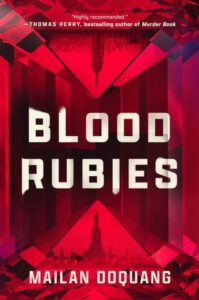An honorable serial killer. A hacker turned vigilante. A gentleman thief. Mysteries and thrillers are full of morally ambiguous antiheroes who challenge us to confront truths about human nature and undermine strict definitions of good and evil. From Dostoevsky’s Raskolnikov to S. A. Cosby’s Beauregard, these compelling but deeply flawed characters operate outside the law, while also adhering to their own moral codes. One person’s hero is another person’s villain. Morally ambiguous characters capture this complexity, reminding us that the world is neither black nor white, but a slippery combination of both.
A morally gray antihero anchors my debut, Blood Rubies, an international thriller set in the thrumming cities of New York and Bangkok. The book follows Rune Sarasin, a half American, half Thai jewel thief thrust into the unwanted role of savior after her latest heist goes sideways and her boyfriend’s sister vanishes from a Bangkok slum. I knew from the outset that I wanted my protagonist to straddle different worlds, not just racially and culturally, but also morally. Rune is an outsider in every sense of the word. Her white mother, her American upbringing, and her shaky grasp of the Thai language make her as alien in Bangkok as her Asian half makes her in the US. Rune is rebellious, self-serving, and blunt to the point of rudeness. These traits, along with her criminality, would seem to place her squarely in the villain camp. But Rune is more than the sum of her flaws and questionable actions, she’s also protective, fiercely loyal, and selfless in her efforts to save her loved ones. This combination of the good and the bad, of the admirable and the abhorrent, is precisely what makes Rune relatable. The sense that the Runes of the world are just like us, except more extreme, helps account for their enduring appeal.
Morally ambiguous characters allow us to give up on the idea of moral purity without abandoning our sense of self as moral beings. Jeff Lindsay’s Dexter Morgan, bloodstain pattern analyst by day, serial killer by night, is a prime example. Dexter kills without legal authority or due process—and with immense pleasure! Thanks to his adoptive father, however, Dexter channels his homicidal impulses in a “positive” way by only killing violent criminals he believes escaped justice. Dexter’s strong moral code serves as a counterpoint to his decidedly immoral actions, compelling us to consider the ethics of vigilantism and the blurred lines between right and wrong. The same can be said of Lisbeth Salander, Stieg Larsson’s justice-seeking hacker who hunts down and violently punishes men who abuse women. Both Lindsay and Larsson foster empathy for their characters by highlighting their altruistic motives and the traumatic experiences fueling their misdeeds. Dexter was just a toddler when a drug dealer killed his mother and locked him in a crate with her dismembered body, while Lisbeth suffered repeated abuse at the hands of her father, her psychiatrist, and her court-appointed guardian. Empathizing with characters whose values don’t square with our moral precepts sends an important message: you don’t have to be a paragon of virtue to deserve understanding and forgiveness. If vigilantes are redeemable, then, surely, we are, too.
As a writer and lover of thrillers, the allure of morally ambiguous characters lies in their potential for heightened suspense. Heroes behave in predictably heroic ways, exhibiting courage in the face of danger and selflessly putting the greater good ahead of their personal interests. Conversely, villains use manipulation, deceit, intimidation, violence, and other nefarious tactics to pursue their desires regardless of the harm it might bring to others. Although heroes and villains occupy opposite ends of the morality spectrum, they share several key traits, including a keen intelligence, determination, imagination, and, most important in this context, constancy. I never wonder if Jack Reacher will back down from a fight, or if Jane Rizzoli and Maura Isles will wash their hands of a difficult case, despite being fully fleshed out by their authors. Their heroic attributes override whatever character flaws they might have. Similarly, I know that the Sandman will kill, that Adora Crellin will abuse her daughters, and that, if it weren’t for the creepy mask, Hannibal Lector would eat my face. Morally gray characters take away this certainty, building suspense into stories by keeping us guessing about what they’ll do next. Unrestrained by the moral code of conventional heroes, antiheroes zig when we expect them to zag, adding uncertainty to scenarios that might otherwise unfold in predictable ways.
As a longtime fan of Maurice Leblanc’s Arsène Lupin stories, thieves are by far my favorite literary antiheroes and the direct inspiration for Rune. A witty, dapper, and charming master of disguise, Lupin navigates the world according to his own moral compass, only stealing from the rich, redistributing wealth to the poor, and always being a gentleman of his word. Contemporary authors have also fueled my love for contradictory characters. A recent standout is Grace Li, whose New York Times bestseller, Portrait of a Thief, tells the story of five young Chinese Americans hired to steal back looted art from world-class museums. Li’s characters are not just motivated by a $50 million reward, but also by a deep desire to combat the legacy of colonialism and to right historical wrongs. Similarly, Beauregard “Bug” Montage in Cosby’s award-winning Blacktop Wasteland resumes his life of crime both to save his family from financial ruin and for the thrill of being the best getaway driver on the East Coast. The popularity of Li’s and Cosby’s books, both of which are being adapted for the screen, speaks to the continued appeal of the antihero archetype. Love to hate them? Hate to love them? When it comes to antiheroes, you’re sure to do both.
***


















